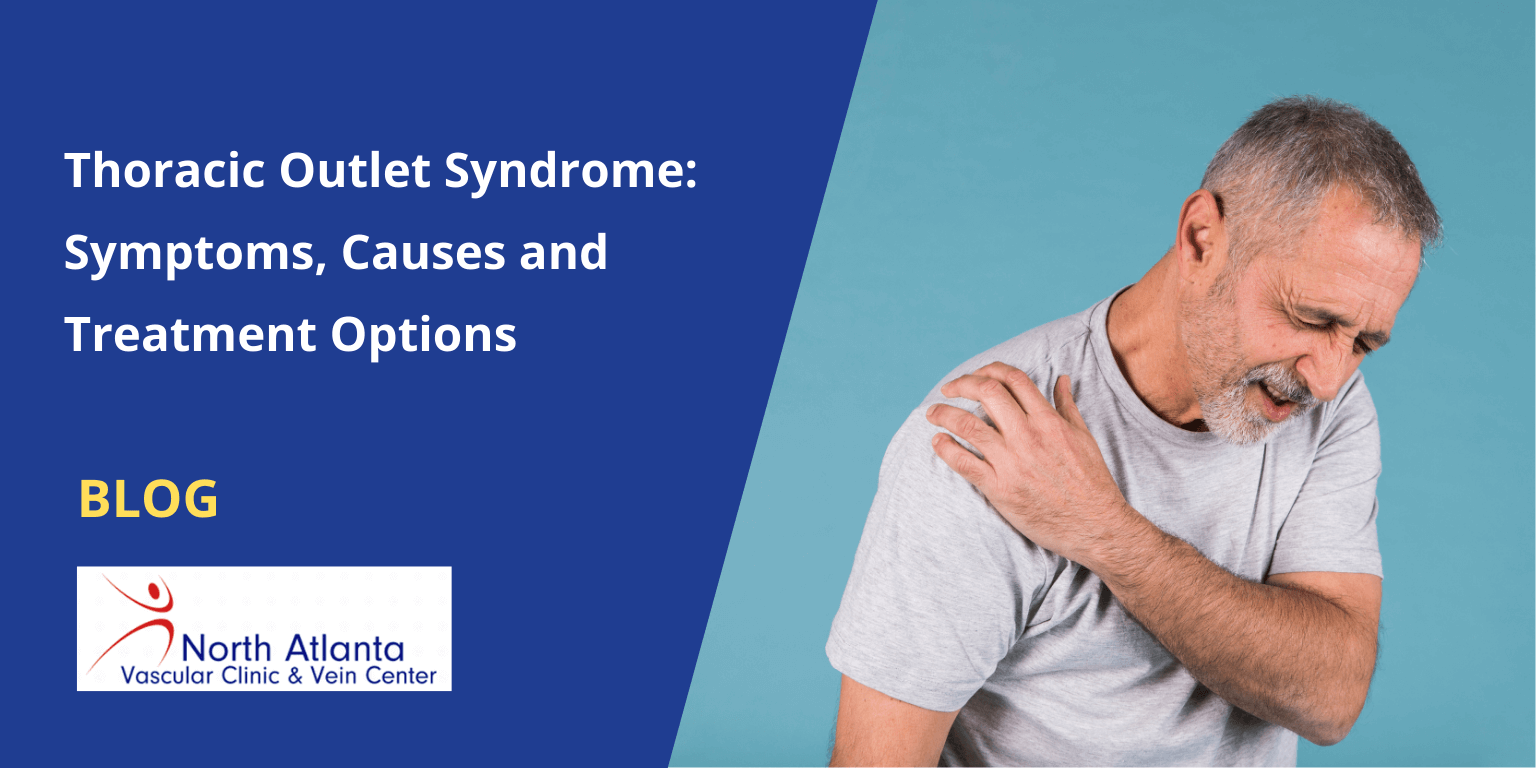Have you ever experienced a nagging pain in your shoulder or neck that travels down your arm, accompanied by tingling or numbness in your fingers? These could be signs of Thoracic Outlet Syndrome (TOS), a condition arising from compressed nerves or blood vessels in the upper chest. The thoracic outlet is a narrow passage between your collarbone and ribs, crowded with nerves, arteries, and veins. TOS develops when muscles or bones in this area put excessive pressure on these vital structures. This blog explores thoracic outlet syndrome, its causes, symptoms, different types, and available treatment options.
Understanding Thoracic Outlet Syndrome (TOS)
The thoracic outlet is a narrow passageway between your collarbone (clavicle) and first rib. It serves as a vital channel for nerves and blood vessels traveling from your neck and shoulder down your arm. Thoracic outlet syndrome (TOS) arises when these nerves or blood vessels become compressed in the thoracic outlet. This compression can lead to various symptoms affecting the arm, shoulder, and neck.
Types of Thoracic Outlet Syndrome
There are three main types of TOS, each affecting different structures in the thoracic outlet:
- Neurogenic Thoracic Outlet Syndrome: This is the most common type of TOS, accounting for roughly 90% of cases in the US. It occurs when the brachial plexus, a network of nerves originating from the spinal cord and travelling down into the shoulder, arm, and hand, becomes compressed.
- Vascular Thoracic Outlet Syndrome: This type occurs when the blood vessels, such as the subclavian artery or vein, are compressed, leading to reduced blood flow to the arms and hands.
- Nonspecific Thoracic Outlet Syndrome: Some cases of TOS do not fit into the neurogenic or vascular categories. Symptoms may be present without clear compression of nerves or blood vessels, making diagnosis and treatment more challenging.
Symptoms of Thoracic Outlet Syndrome
The symptoms of TOS can vary depending on the type and severity of the condition. Here are some common symptoms:
- Pain in the neck, shoulder, and arm, especially with overhead activities
- Numbness, tingling, or burning sensation in the arm and hand
- Weakness in the arm and hand
- Feeling of heaviness in the arm
- Discoloration of the arm (pale or bluish)
- Swollen veins in the arm
Causes and Risk Factors
Several factors can contribute to TOS. Here's a breakdown of some common causes and risk factors:
- Anatomical Variations: Some people are born with an extra rib (cervical rib) that can compress the nerves or blood vessels.
- Muscle Tightness: Tightness in the neck, shoulder, and chest muscles can compress the thoracic outlet.
- Poor Posture: Slouching or hunching can narrow the thoracic outlet space.
- Repetitive Overhead Activities: Activities that involve repetitive overhead arm movements, such as weightlifting or certain sports, can increase the risk of TOS.
- Trauma: Injuries to the neck, shoulder, or chest can damage tissues and lead to TOS.
- Carrying Heavy Bags: Regularly carrying heavy bags on one shoulder can put a strain on the muscles and nerves in the thoracic outlet
Diagnosing Thoracic Outlet Syndrome
Diagnosing TOS can be challenging due to the variety of symptoms and the overlap with other conditions. However, several tests and procedures can help confirm a diagnosis:
- Physical Examination: Your healthcare provider will perform a thorough examination of your neck, shoulders, and arms to assess your range of motion, strength, and sensation.
- Imaging Tests: X-rays, MRI, or CT scans may be ordered to visualize the structures in the thoracic outlet and identify any abnormalities or compression.
- Nerve Conduction Studies: These tests measure the electrical activity of the nerves and can help identify areas of nerve compression or dysfunction.
- Vascular Studies: Doppler ultrasound or angiography to assess blood flow and detect vascular compression.
Treatment Options for Thoracic Outlet Syndrome
The treatment for TOS depends on the severity of your condition and the type of compression. Here are some common treatment approaches:
- Physical Therapy: Exercises to improve posture, strengthen muscles, and enhance flexibility in the chest and shoulder can significantly reduce compression and improve symptoms.
- Medication: Anti-inflammatory medications may be prescribed to manage pain and inflammation.
- Lifestyle Modifications: Avoiding activities that aggravate symptoms, maintaining good posture, and practicing relaxation techniques can all be beneficial.
- Surgery: In severe cases where conservative treatment fails, surgery may be necessary to remove an extra rib, release tight ligaments, or reposition other structures causing compression.
How to Prevent Thoracic Outlet Syndrome?
While some risk factors for TOS, such as anatomical variations, cannot be prevented, there are steps you can take to reduce your risk of developing the condition:
- Maintain Good Posture: Practice proper ergonomics when sitting, standing, and lifting objects to reduce strain on the neck and shoulders.
- Take Regular Breaks: Avoid prolonged periods of sitting or standing in one position. Take breaks to stretch and move your arms and shoulders.
- Avoid Repetitive Activities: Vary your activities throughout the day to prevent overuse of certain muscles and reduce the risk of developing TOS.
Final Thoughts
Thoracic Outlet Syndrome can significantly impact an individual's quality of life, but with early diagnosis and appropriate treatment, symptoms can be managed effectively. It is essential to seek medical advice if you experience persistent pain, numbness, or weakness in your shoulders, arms, or hands. By understanding TOS and taking proactive measures, individuals can minimize the impact of this condition on their daily lives.
Find Relief for Thoracic Outlet Syndrome at North Atlanta Vascular Clinic!
Are you seeking relief from Thoracic Outlet Syndrome? Look no further than North Atlanta Vascular Clinic. Our experienced team specializes in diagnosing and treating TOS, ensuring personalized care to alleviate your symptoms and prevent long-term complications. Conveniently located in Suwanee/Johns Creek, Alpharetta, Cumming, and Lawrenceville, Georgia, our clinics provide accessible solutions tailored to your needs. Contact us today and start your journey towards a pain-free future.
